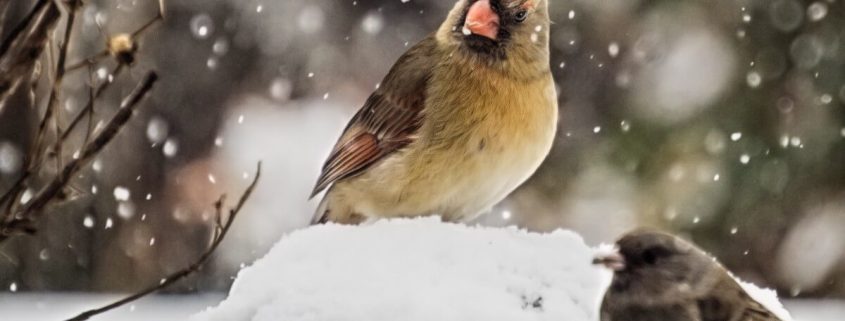Whether you are thinking of implementing a new bird bath in your winter landscape or caring for one you currently have, this article will serve as a guideline to take proper care of it and its guests. Let’s get started.
Know your neighborhood.
It may be helpful to first know the birds that live in your neighborhood and what their migration patterns are. Do the bird species living in your neighborhood overwinter (not migrate at all), and if not, when, in what month do they migrate and when do they return? It’s also helpful to know your region’s weather patterns. When, if at all, do bodies of water freeze?
Buy the best material for withstanding the weather.
Depending on the weather patterns of your winter season, you should choose the appropriate material for a bird bath that will stand the test of time. If water repeatedly freezes and thaws in your region, you should avoid baths made of cement, stone, or glass. The best material, no matter where you live, is plastic or resin. These materials are shatterproof and can take the changes of the season. Dark colors are best because they attract the sun’s warmth.
Keep your bird bath warm using these tips.
- Strategically place your bird bath to get the most exposure to the sun, the same way you do with house plants.
- An insulating blanket wrapped around your bath will also aid it in keeping warm.
- Prevent freezing by using the element of wind. If you place a ball on the top of the water, the wind will keep it moving along the bath and prevent thin layers of ice from forming.
- Plastic liner products will make it easy to remove any ice that has formed.
- You can also heat water on the stove, let cool a little, and then pour it into an existing freezing over bird bath to stop the freezing process. Never add boiling water to a bird bath, use excessive force trying to break ice, or antifreeze chemicals or salt. They are not safe for your bird bath or more importantly, your bird friends!
- And last, but definitely not least, an electric-heated bird bath option is available for purchase, but are the most expensive option. If you live in an extreme weather region, this may be your only option.



